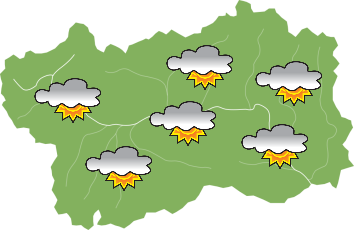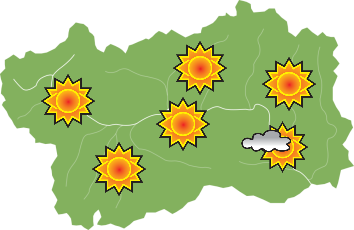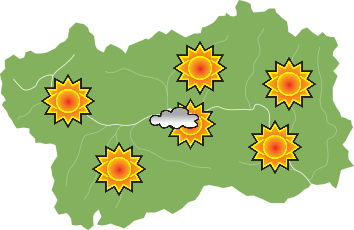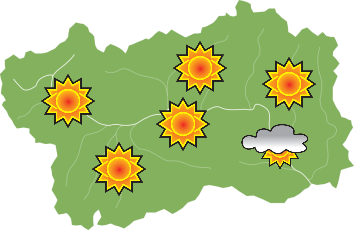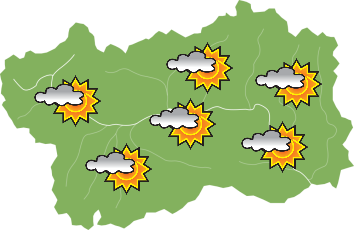Fortress of Bard
Resort: Bard
Special openings:
Christmas Holidays:
December 24th (Christmas Eve): 10:00 AM - 6:00 PM
December 25th (Christmas): Closed
Open daily from December 26th to January 6th: 10:00 AM - 8:00 PM
Exceptions:
December 31st: 10:00 AM - 6:00 PM
January 1st: 2:00 PM - 8:00 PM
Fortress
The ticket office closes 1 hour before the fortress’s closing time.
- Tuesdays to Fridays 10 a.m. – 6 p.m.
- Saturdays, Sundays and on public holidays 10 a.m. – 7 p.m.
The Alps Museum:
open following the Fortress timetable
Il Ferdinando, fortresses and frontiers Museum:
open following the Fortress timetable
The Fortress’ Prisons:
- Tuesdays to Fridays 11 a.m. – 6 p.m.
- Saturdays, Sundays and on public holidays 11 a.m. – 7 p.m.
Opening times are subject to variations: we advice to verify them on the web site reported in the “Contact” area.
• The Caffetteria di Gola is open to the public
• The ticket office is open but it is recommended to use the online sales channels
Reduced 19 - 25 years and 19 - 25: € 12.00
- Fort All-inclusive (all the museums + all the exhibitions): € 24.00
——————————————————-
Reduced entrance-fee for:
- visitors > 65 years and 19 - 25 years
- university students with student ID
- groups: reduced ticket price for groups of 12 or more; one free ticket for every 20 paying visitors.
Free admission for:
- Kinder und Jugendliche unter 18 years
- disabled visitors
- tourist guides and journalists on duty and provided with professional card.
For special reductions (groups, families, schools, conventions), guided visits and combined tickets for visiting different spaces, please contact the Fortress’ ticket office.
• access to the Fort from the medieval village through an easy panoramic walk outside. The disabled and their companions, people with walking difficulties and families with pushchairs can use the panoramic elevators.
• the ticket offices are open but we invite you to purchase tickets online on the fortedibard.it website
Accessibility
Wheelchairs:
The Fort has no architectural barriers and each level can be reached by lifts or pedestrian paths equipped with ramps: independent access is possible for disabled people, prams and strollers.
A wheelchair is available upon request for the public with mobility difficulties to facilitate visits to the exhibition spaces. It is advisable to contact the telephone + 39 0125 833818 in advance.
Blind and visually impaired:
To learn about the history of the monumental site, blind people can consult three totems equipped with braille descriptions and relief maps located in an easily accessible area, on the second floor of the multi-storey car park. Models of the Fort are also available in correspondence with the main buildings.
Contact
The Bard fortress houses four interesting museums and hosts important temporary exhibitions and cultural events.
You can access the top of the fortress by following the pedestrian path, which runs between mighty walls starting from the interesting medieval village next to the car park, or you can use the panoramic lifts through which you can enjoy a wonderful view of the surrounding valley and the medieval village.
Remaining almost intact since its construction, the Bard fort represents one of the best examples of a barrier fortress from the early nineteenth century.
The fortress is made up of three main buildings: starting from the bottom are the Opera Ferdinando, the middle building, - Opera Vittorio - up to the top of the relief, where the Opera Carlo Alberto stands. The latter is the most imposing of the three works, which encloses within it the large quadrangular courtyard of the Piazza d'Armi, surrounded by a large portico, where the spaces dedicated to temporary exhibitions are located.
History of the Fort
Already during Theodoric’s reign (early 6th century A.D), sixty armed soldiers were garrisoned to defend the “Clausuræ Augustanæ” (a defence system set up to protect the borders of the Empire) in Bard.
In 1034, it was described as “inexpugnabile oppidum”, in one of the oldest references to a castle in Valle d’Aosta. The Savoys became the Lords of Bard in 1242, with Amadeus IV, driven by the insistence of the local inhabitants, who were tired of the abuse of power by Hugh of Bard, who exploited the position of his castle to levy heavy duties on travellers and merchants.
From that time on, the castle was always controlled by the Savoys, who held a garrison there. In 1661, the armies from other fortresses in Aosta Valley, including Verrès and Montjovet, converged in Bard.
The castle took on renewed importance with the passage of the French army in 1704 and particularly in May 1800 on the arrival of Napoleon Bonaparte, who found a garrison of 400 Austrian men within the fortress. The defence structures of the fortress were so efficient that Napoleon’s army took about two weeks to overcome the Austrian defences, eventually succeeding thanks to cunning tactics. The fortress was then dismantled by Napoleon, to avoid further problems.
The current appearance of the fort is the result of reconstruction work commissioned by Carlo Felice, at the height of the Restoration, which, from 1830 onwards, turned it into one of the largest military structures in the Aosta Valley. At the end of the 19th century the fort began to decline, first used as a penal colony and then as a weapons depot. Decommissioned in 1975 by the military, it was acquired by the Aosta Valley region in 1990 and completely renovated in 2006.
The Museum of the Alps
Located on the first floor of the Opera Carlo Alberto, the Museum of the Alps is an interactive space through which the visitor can travel to discover the Alpine world, exploring with the five senses a mountain experienced and transformed by the hand of man. The rooms of the exhibition route are divided into four sections, which address the mountain from a naturalistic, geographical, anthropological and meteorological point of view, involving guests of all ages, thanks to the fusion between tradition and new technologies.
The Alps of the kids
The Museum The Alps for Kids, housed within the Opera Vittorio at the Forte di Bard, is an immersive journey into the heart of the Alps, designed for schools, families and nature enthusiasts. It is a path that invites reflection on climate change and its effects on alpine ecosystems: glacier retreat, diminished snow cover, rising temperatures and the transformations these bring.
From the moment you enter, a large geodesic tent welcomes visitors in an immersive atmosphere of sounds, images and lights: here one receives the first “coordinates” to begin exploration. The path then unfolds through different halls, each dedicated to one of the four symbolic peaks of the Aosta Valley - Monte Rosa, Matterhorn, Gran Paradiso and Mont Blanc - and their glacial zones.
The Prisons
The narrow cells where prisoners were locked up now host a historical itinerary that leads to the discovery of the history of the military site, a strategic transit point for centuries. Through films, documents and high-impact 3D reconstructions, you can discover the architectural evolution of the fortress and the historical figures who have marked its main events: from the year 1000 to its reconstruction in 1830, up to the present day.
Museum of Fortifications and Borders
Located in the Opera Ferdinando, on the first level of the fortress, the museum takes visitors on a journey through the evolution of defensive techniques and borders. Through models, films and authentic weapons, you can discover how fortresses have transformed from Roman times to the twentieth century. A special section invites you to reflect on the concept of frontier, offering a look at the role of the Bard Fort in the historical and geopolitical context of various eras.





